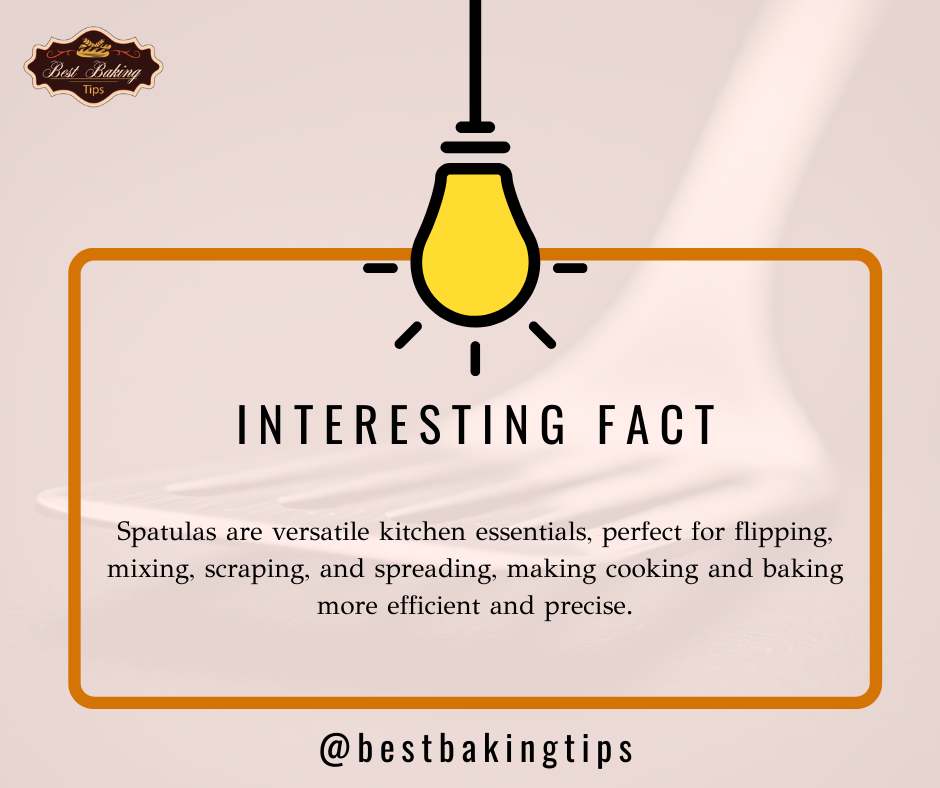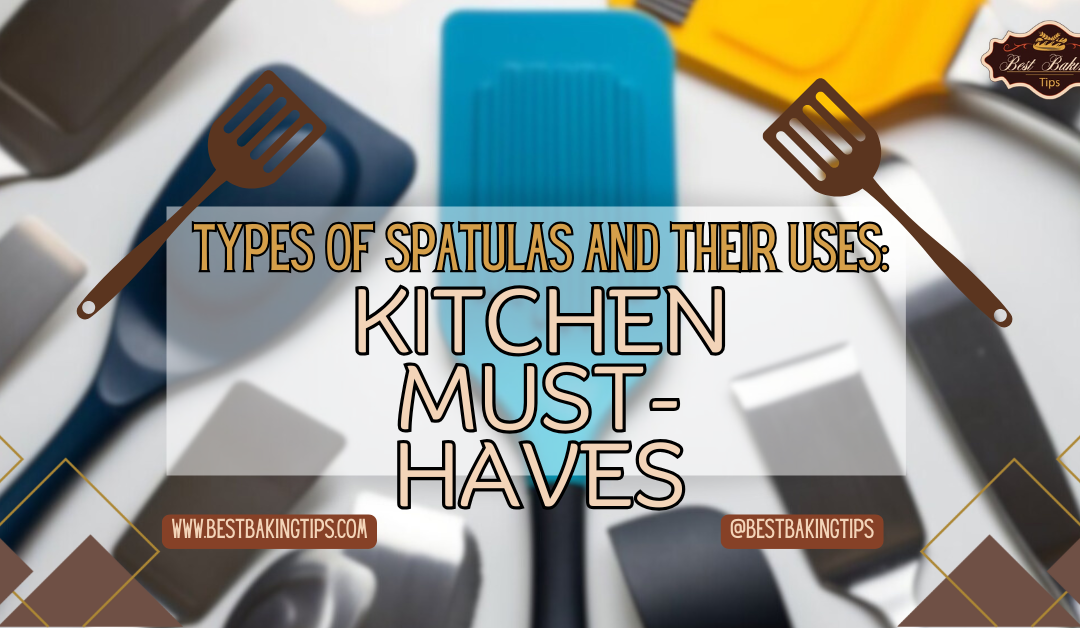==================
Affiliate Statement
Best Baking Tips is supported by our audience. When you purchase through one of our links, we may earn a small affiliate commission. As an Amazon Associate I earn from qualifying purchases. Your cost is not affected.
==================
When it comes to cooking, understanding the types of spatulas and their uses can make a significant difference, and one kitchen essential that is often overlooked is the spatula. Whether you are flipping pancakes, scrambling eggs, or scraping the last bit of batter from a mixing bowl, a spatula plays a key role in achieving the perfect dish. However, not all spatulas are the same. Each one serves a distinct purpose, making it important to select the right tool for each task. In this article, we will explore the different types of spatulas and how they can enhance your cooking.
From heat-resistant silicone spatulas for stirring in hot pans to flexible turners for flipping delicate foods, knowing which spatula to use for every job can improve both the efficiency and enjoyment of your time in the kitchen. Whether you are an experienced cook or just starting to build your kitchen essentials, understanding these versatile tools will help you cook with confidence and precision. Keep reading to discover which spatula is a must-have in your kitchen.
I remember my Grandma scraping the bowl with her rubber spatula to get the last bit of cake batter into the pan. I stood close as she always left a little in the bowl and on the spatula for me. Spatulas are handy tools that make cooking and baking easier. They come in many shapes and sizes, each with a special job in the kitchen.
Different types of spatulas include fish spatulas, offset spatulas, rubber spatulas, and grill spatulas, among others. When you’re flipping pancakes, spreading frosting, or scraping the last bit of batter from a bowl, you need the right spatula for the job.
Some spatulas are made of metal or stainless steel, which are great for high-heat cooking. Others are made of silicone or rubber, perfect for use with non-stick pans. Picking the right spatula can make your cooking tasks much easier.
Understanding the different types of spatulas and their uses is key to making the best choice for every cooking task. Whether you’re a beginner cook or a pro chef, knowing which spatula to use will help you get the best results in the kitchen.
Key Takeaways
- Different spatulas are designed for unique tasks, such as flipping, spreading, or scraping, ensuring efficiency in the kitchen.
- The material of a spatula (silicone, metal, wood, or plastic) influences its functionality and compatibility with various cookware, like non-stick pans or grills.
- Choosing the correct spatula based on the task—whether it’s for delicate tasks like frosting cakes or flipping burgers—can enhance your cooking results.
- From ancient wooden paddles to modern silicone designs, spatulas have evolved to suit various cooking needs, offering better flexibility and heat resistance.
- Regular cleaning, drying, and careful storage will keep your spatulas in top condition, ensuring their longevity and performance.

Understanding Spatulas
History and Evolution
Spatulas have been around for a long time. Ancient Egyptians used wooden paddles to mix and spread food. In the Middle Ages, people started using metal spatulas for cooking.
The 20th century brought big changes. New materials like plastic and silicone became popular. These new spatulas were more flexible and heat-resistant. Today, you can find spatulas for all kinds of tasks. There are special ones for baking, grilling, and even applying makeup!
Material Differences and Properties
Spatula materials affect how well they work. Here’s a quick look:
- Silicone: Great for high heat, won’t scratch pans, easy to clean
- Metal: Durable and thin, perfect for flipping and grilling
- Wood: Won’t melt or scratch, but can absorb flavors
- Plastic: Cheap and light, but can melt at high temps
Silicone spatulas are super flexible. You can use them to scrape bowls clean. Metal spatulas are strong and thin. They’re great for flipping burgers on the grill.
Wooden spatulas are gentle on pans. But they can hold onto smells and stains. Plastic spatulas are cheap and come in fun colors. Just be careful not to use them on very hot pans!
Types of Spatulas and Their Specializations

Offset Spatulas
Offset spatulas have a unique angled blade that keeps your hand away from the food. You’ll love using these for spreading frosting on cakes and smoothing out batters. The long, narrow blade gives you great control for detailed work.
These tools are perfect for getting into tight corners of pans. You can use them to lift delicate cookies off baking sheets without breaking them. Offset spatulas come in different sizes, from mini versions for small tasks to longer ones for big cakes.
When frosting a cake, start with a crumb coat using the flat side of the blade. Then, use the edge to create smooth sides and sharp corners. You’ll get professional-looking results every time!
Turners and Flipper Spatulas
Turners are your go-to tools for flipping foods. They have wide, flat blades that slide easily under food. You’ll use these for everything from pancakes to burgers.
Fish turners have a thin, flexible blade with slots. These help drain oil and let you lift delicate fish filets without breaking them. For grilling, look for sturdy metal turners with long handles to keep your hands safe from the heat.
When using a turner, slide it completely under the food before lifting. This prevents breaking or tearing. For best results on non-stick pans, choose a nylon or silicone turner to protect the coating.
Flat and Slotted Spatulas
Flat spatulas are versatile tools for many tasks. You can use them to cut and serve soft foods like brownies or lasagna. Slotted versions let liquids drain, making them great for lifting fried foods out of oil.
Perforated spatulas have small holes that allow even more drainage. These are perfect for removing cookies from baking sheets or draining blanched vegetables.
For non-stick cookware, choose silicone or nylon spatulas to avoid scratching. Metal spatulas work well for cast iron or stainless steel pans. They can help scrape up tasty browned bits from the pan bottom.
Scrapers and Spreaders
Rubber and silicone spatulas are your best friends for scraping bowls clean. Their flexible edges conform to curved surfaces, so you don’t waste a drop of batter or sauce. Baked rubber spatulas can handle high heat, making them great for stovetop cooking too.
Spreaders have a broad, flat blade perfect for spreading mayo on sandwiches or butter on toast. Some have serrated edges to help cut through bread.
Spoonulas combine a spatula with a spoon shape. Use these for folding ingredients or serving saucy dishes. They’re especially handy for getting the last bit of peanut butter out of the jar!
Did You Know?
Check out this video on the different types of kitchen spatulas and their uses.
By: Chef Remi
Can a Spoon Be Used in Place of a Spatula?

Spoons can work for some spatula tasks. You can use a spoon to spread frosting on a cake or mix ingredients in a bowl. They’re also good for scooping and serving food. But spoons have limitations. They can’t flip pancakes or burgers like a turner spatula can. Their rounded shape makes it hard to scrape bowls clean or get into corners.
Selecting the Best Spatula for Your Needs
Considerations for Compatibility with Cookware
When selecting a spatula, think about your pots and pans. Silicone spatulas are great for nonstick cookware, as they won’t scratch the surface. Metal spatulas work well with stainless steel or cast iron.
For grilling, a sturdy metal spatula is your best bet. It can handle high heat and won’t melt. If you often cook eggs, look for a thin, flexible spatula. This will help you flip delicate foods without breaking them.
Evaluating Spatula Features
Pay attention to the spatula’s handle. An ergonomic grip will make your cooking more comfortable, especially for long sessions. Heat resistance is key. Silicone spatulas can usually withstand temperatures up to 600°F. This makes them versatile for various cooking tasks.
Look at the blade’s flexibility. A slightly flexible blade is great for scraping bowls and getting under food. But for flipping heavier items, you’ll want a stiffer spatula.
Consider getting a set with different types. This gives you options for various cooking needs. Many sets include a mix of sizes and materials. Remember, the best spatula for you depends on what and how you cook. Think about your favorite dishes and choose accordingly.
Caring for Your Spatulas

Cleaning Best Practices
Wash your spatulas after each use. For silicone spatulas, use warm soapy water and rinse well. Scrub off any stuck-on food. For wooden spatulas, avoid soaking them. Wash quickly with mild soap and dry right away. This prevents the wood from cracking.
Metal spatulas can go in the dishwasher. But hand washing is gentler and can help them last longer. Always check the maker’s instructions. Some spatulas need special care. For tough stains, try soaking in warm water with baking soda. This can help lift grease and food bits.
Maintenance and Storage Tips
Dry your spatulas completely before putting them away. This stops bacteria from growing. Store spatulas in a clean, dry drawer or utensil holder. Keep them away from heat sources.
Check wooden spatulas for cracks or splinters. Sand down any rough spots to prevent splinters in your food. Oil wooden spatulas every few months with food-grade mineral oil. This keeps the wood from drying out.
Replace rubber or silicone spatulas if they start to melt or crack. Damaged spatulas can harbor bacteria. Hang metal spatulas or store them flat. This prevents bending or warping.
Innovative Uses and Techniques

Creative Culinary Applications
You can use a rubber spatula for mixing and folding delicate batters. Try folding whipped cream into mousses or gently combining ingredients for fluffy pancakes.
For baking, use an offset spatula to create smooth frosting on cakes. You can also use it to spread batter evenly in a pan for perfectly level cakes.
When grilling, a sturdy grill spatula isn’t just for flipping burgers. Use it to press down on meats for even cooking or to separate foods that might stick together.
Professional Techniques for Amateur Chefs
You can use a fish spatula to transfer delicate fish fillets without breaking them. Its thin edge slides easily under food, making it great for removing cookies from baking sheets too.
Try using a palette knife for fine dining plating. You can create beautiful swooshes of sauce or precisely place small food items. For scraping, use a bowl scraper to get every last bit of batter or dough from your mixing bowl.
This reduces waste and ensures consistent portions. In pastry making, you can use an offset spatula to create textured patterns in buttercream or to smooth the top of tarts before baking.
Check out this video on the four essential types of spatulas every kitchen needs.
By: Scoop School
Mastering the Kitchen: A Guide to Types of Spatulas and Their Uses
In conclusion, understanding the various types of spatulas and their uses can significantly enhance your cooking experience. Each spatula is designed with a specific task in mind, making it essential to select the right tool for the job. From silicone spatulas that are perfect for non-stick cookware to metal turners ideal for flipping burgers on the grill, choosing the appropriate spatula can improve efficiency and ensure the best results in your kitchen. By using the correct spatula, you can avoid damaging your cookware while achieving more precise and enjoyable cooking outcomes.
Ultimately, knowledge of the different types of spatulas and their uses helps you cook with confidence, whether you’re an amateur or an experienced chef. From scraping the last bit of batter out of a bowl to spreading frosting on a cake, these versatile kitchen tools make everyday cooking tasks easier. By investing in a variety of spatulas tailored to your specific needs, you’ll be well-equipped to handle any culinary challenge and elevate your cooking skills.
Frequently Asked Questions
Spatulas come in many forms and serve various purposes in the kitchen. Let’s explore some common questions about these versatile tools to help you choose and use them effectively.
What Are the Various Types of Kitchen Spatulas and Their Specific Uses?
Kitchen spatulas come in several types. Turner spatulas are great for flipping foods like pancakes or burgers. Rubber spatulas help scrape bowls clean. Offset spatulas are perfect for frosting cakes. Fish spatulas have a thin, flexible blade ideal for delicate fish fillets.
How Can You Differentiate Between a Straight Spatula and an Offset Spatula?
A straight spatula has a flat blade in line with the handle. An offset spatula has a blade that’s angled down from the handle. This design makes it easier to spread icing on cakes or smooth batter in a pan.
What is a Slotted Turner and How is It Different From Traditional Spatulas?
A slotted turner has holes or slots in its blade. These openings allow liquids to drain as you lift food. This feature makes slotted turners ideal for removing fried foods from oil or lifting vegetables from boiling water.
Why Not Use a Spoon Instead of a Spatula?
While spoons are useful, spatulas offer advantages. Their flat, wide surface is better for scraping bowls and pans. Spatulas can also slide under foods easily for flipping. Their design allows for more precise control when spreading or smoothing ingredients.
What Are Some Factors to Consider When Choosing the Right Spatula for Your Cooking Needs?
Think about the material. Metal spatulas are great for high heat, while silicone won’t scratch non-stick pans. Consider the size and shape of the blade for your typical tasks. Also, look at the handle length and material for comfort and heat resistance.
Unleash Your Baking Skills With Us!
Ready to elevate your baking experience to new heights? No matter your current expertise, there’s always a fresh tip or method waiting to be explored and perfected.
Connect with us on Facebook, Instagram, Pinterest, Twitter, and TikTok.
Become part of our vibrant baking community and uncover the secrets to crafting delicious creations in your own kitchen!






